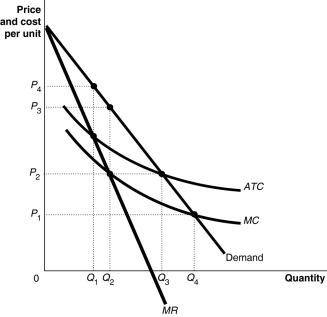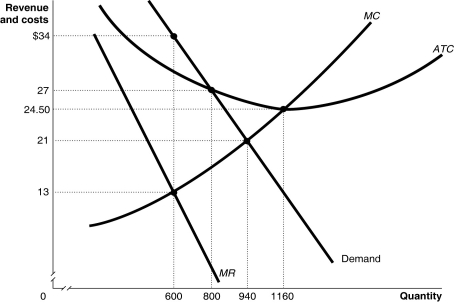B) False
Correct Answer

verified
False
Correct Answer
verified
Multiple Choice
A narrow definition of monopoly is that a firm is a monopoly if it can ignore
A) government antitrust laws.
B) the pricing decisions of its suppliers.
C) the pricing decisions of firms that produce complementary products.
D) the actions of all other firms.
F) B) and C)
Correct Answer

verified
Correct Answer
verified
Multiple Choice
Figure 15-15  Figure 15-15 shows the cost and demand curves for the Erickson Power Company.
-In regulating a natural monopoly, the price strategy that ensures the highest possible output and zero profit is one that sets price
Figure 15-15 shows the cost and demand curves for the Erickson Power Company.
-In regulating a natural monopoly, the price strategy that ensures the highest possible output and zero profit is one that sets price
A) equal to average total cost where it intersects the demand curve.
B) equal to marginal cost where it intersects the demand curve.
C) equal to average variable cost where it intersects the demand curve.
D) corresponding to the demand curve where marginal revenue equals zero.
F) A) and D)
Correct Answer

verified
Correct Answer
verified
Multiple Choice
Figure 15-15  Figure 15-15 shows the cost and demand curves for the Erickson Power Company.
-Economic efficiency requires that a natural monopoly's price be
Figure 15-15 shows the cost and demand curves for the Erickson Power Company.
-Economic efficiency requires that a natural monopoly's price be
A) equal to average total cost where it intersects the demand curve.
B) equal to marginal cost where it intersects the demand curve.
C) equal to average variable cost where it intersects the demand curve.
D) equal to the lowest price the firm can charge and still make a normal profit.
F) A) and C)
Correct Answer

verified
Correct Answer
verified
Multiple Choice
Using a broad definition, a firm would have a monopoly if
A) it produced a product that has no close substitutes.
B) it does not have to collude with any other producer to earn an economic profit.
C) there is no other firm selling a substitute for its product close enough that its economic profits are competed away in the long run.
D) it can make decisions regarding price and output without violating antitrust laws.
F) None of the above
Correct Answer

verified
Correct Answer
verified
Multiple Choice
Which of the following statements is true?
A) Monopolists are price makers. All other firms are price takers.
B) Unlike other industries, monopoly industries have high barriers to entry.
C) Only monopoly firms are granted patents and copyrights.
D) Unlike other firms, a monopolist's demand curve is the same as the market demand curve.
F) A) and B)
Correct Answer

verified
Correct Answer
verified
True/False
Most pharmaceutical firms selling prescription drugs continue to earn economic profits long after the patents on the prescription drugs expire because they have established a strong foothold in the market.
B) False
Correct Answer

verified
Correct Answer
verified
Essay
U.S. antitrust laws are designed to prohibit monopolization and encourage competition. Why, then, does the government erect barriers to entry and create monopoly power by granting firms patents?
Correct Answer

verified
Patents are designed to encourage creative activity and promote the development of new technologies. Firms can spend years on research and development in the search for new and better production processes and consumer products. Research and development is costly-many potential new ideas are ultimately not technically feasible or never become commercially successful. If research and development results in a successful product, competing firms can easily copy the product and sell it without incurring the research costs of the firm that developed the product, if patent protection is not granted. Most people would object to this form of "free riding" on equity grounds; but patents also encourage firms to conduct research that leads to social benefits: new technologies result in a higher standard of living for all and a more efficient allocation of society's scarce resources.
Correct Answer
verified
Multiple Choice
Which two factors make regulating mergers complicated?
A) First, firms may lobby government officials to influence their decision to approve the merger. Second, by the time the government officials reach a decision regarding the merger, the firms often decide not to merge.
B) First, the time it takes to reach a decision to approve a merger is so long that the firms often have new owners and managers. Second, by law, government officials are not allowed to consider the impact of foreign trade (exports and imports) on the degree of competition in the markets of the merged firms.
C) First, the Federal Trade Commission and the Antitrust Division of the U.S. Department of Justice must both approve mergers. Second, the concentration ratios that are used to evaluate the degree of competition the merged firms face are flawed.
D) First, it is not always clear what market firms are in. Second, the newly merged firm might be more efficient than the merging firms were individually.
F) C) and D)
Correct Answer

verified
Correct Answer
verified
True/False
If the market for a product begins as perfectly competitive and then becomes a monopoly, there will be a reduction in economic efficiency and a deadweight loss.
B) False
Correct Answer

verified
Correct Answer
verified
Multiple Choice
Because a monopoly's demand curve is the same as the market demand curve for its product,
A) the monopoly's marginal revenue equals its price.
B) the monopoly is a price taker.
C) the monopoly must lower its price to sell more of its product.
D) the monopoly's average total cost always falls as it increases its output.
F) All of the above
Correct Answer

verified
C
Correct Answer
verified
True/False
If a monopolist's price is $50 at the output where marginal revenue equals marginal cost and average total cost is $43, then the incremental profit from the last unit sold is $7.
B) False
Correct Answer

verified
Correct Answer
verified
Multiple Choice
Figure 15-2  Figure 15-2 above shows the demand and cost curves facing a monopolist.
-Refer to Figure 15-2. If the firm's average total cost curve is ATC3, the firm will
Figure 15-2 above shows the demand and cost curves facing a monopolist.
-Refer to Figure 15-2. If the firm's average total cost curve is ATC3, the firm will
A) suffer a loss.
B) break even.
C) make a profit.
D) face competition.
F) All of the above
Correct Answer

verified
Correct Answer
verified
Multiple Choice
Which of the following is true for a monopolist?
A) Being the only seller in the market, the monopolist faces a perfectly inelastic demand curve.
B) Being the only seller in the market, the monopolist faces a perfectly elastic demand curve.
C) Being the only seller in the market, the monopolist faces the market demand curve.
D) Being the only seller in the market, the monopolist faces a downward-sloping demand curve that lies below the marginal revenue curve.
F) A) and C)
Correct Answer

verified
Correct Answer
verified
True/False
In reality, because few markets are perfectly competitive, some loss of economic efficiency occurs in the market for nearly every good or service.
B) False
Correct Answer

verified
Correct Answer
verified
Multiple Choice
The demand curve for the monopoly's product is
A) the market demand for the product.
B) more elastic than the market demand for the product.
C) more inelastic than the market demand for the product.
D) undefined.
F) C) and D)
Correct Answer

verified
Correct Answer
verified
Multiple Choice
Figure 15-9  Figure 15-9 shows the demand and cost curves for a monopolist.
-Refer to Figure 15-9. What is the difference between the monopoly's price and perfectly competitive industry's price?
Figure 15-9 shows the demand and cost curves for a monopolist.
-Refer to Figure 15-9. What is the difference between the monopoly's price and perfectly competitive industry's price?
A) The monopoly's price is higher by $9.50.
B) The monopoly's price is higher by $13.
C) The monopoly's price is higher by $3.50.
D) The monopoly's price is higher by $21.
F) A) and B)
Correct Answer

verified
Correct Answer
verified
Multiple Choice
Wendell can sell five motor homes per week at a price of $22,000. If he lowers the price of motor homes to $20,000 per week he will sell six motor homes. What is the marginal revenue of the sixth motor home?
A) $10,000
B) $12,000
C) $20,000
D) $22,000
F) B) and C)
Correct Answer

verified
Correct Answer
verified
Multiple Choice
The Aluminum Company of America (Alcoa) had a monopoly until the 1940s because
A) it was a public enterprise.
B) it had a patent on the manufacture of aluminum.
C) the company had a secret technique for making aluminum from bauxite.
D) it had control of almost all the available supply of bauxite.
F) B) and C)
Correct Answer

verified
Correct Answer
verified
Multiple Choice
Figure 15-12  Figure 15-12 shows the cost and demand curves for a monopolist.
-Refer to Figure 15-12. Assume the firm maximizes its profits. What is the amount of consumer surplus?
Figure 15-12 shows the cost and demand curves for a monopolist.
-Refer to Figure 15-12. Assume the firm maximizes its profits. What is the amount of consumer surplus?
A) $21
B) $124
C) $186
D) $332
F) None of the above
Correct Answer

verified
Correct Answer
verified
Showing 1 - 20 of 271
Related Exams